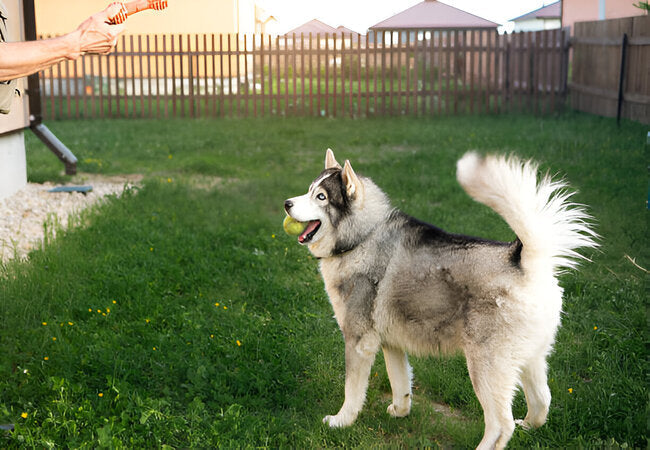Why Dogs Wag Their Tails in 2025 – Vet‑Reviewed Tail Language Guide 🐶📊

In this article
Why Dogs Wag Their Tails in 2025 – Vet‑Reviewed Tail Language Guide 🐶📊
By Dr. Duncan Houston BVSc
Tails aren’t just cute—they’re a nuanced language! A wag can signal happiness, hunting drive, stress—or even dominance. In this 2025 vet-approved guide, we decode tail position, motion, speed & direction, offering real-world interpretation, health alerts, and tips to understand your pup better than ever.
1. Why Dogs Have Tails
Tails aid in balance, movement, pest control—and most importantly, communication. Tail movements are a powerful visual language shaped through domestication to connect with humans.
2. A Wag Is Contextual 🧩
According to PetMD, “a wagging tail simply means the dog is responding to something in their environment”. Psychology Today adds that loose wags indicate friendliness, while stiff, fast wags suggest a more intense emotion—like assertion or agitation. That’s why context and body language matter.
3. Decoding Tail Position
- Tail held high: confidence or dominance; rapid wag signals assertive excitement.
- Horizontal, neutral: curiosity or focus; watch speed to differentiate alertness vs happy interest.
- Low or tucked: insecurity, fear, or submission—especially with slow or absent wag.
4. Wagging Speed & Gesture
- Fast, broad wag: joyful greeting—whole body wiggling indicates true happiness.
- Slow or half-mast wag: uncertainty or cautious interest.
- Rapid tip wag: tense or anxious anticipation—often a warning sign.
5. Wag Direction Matters
Research shows wagging more to the right—driven by left-brain emotion—signals calm, friendly intent. Left-biased wags—right-brain activation—may reflect tension or discomfort.
6. Interpreting Mixed Signals
Dogs may wag while growling, signaling hesitant aggression or conflicted feelings. Context clues—ears, lips, posture—are vital to safe interpretation. A stiff body, fixed gaze, plus a rigid wag = alert or aggressive tone.
7. Health & Behavior Alerts
Observe tail behavior for signs of discomfort:
- Happy-tail syndrome: vigorous wagging can injure the tail tip .
- Limber/swimmer’s tail: Drooping tail after active wag can indicate muscle strain .
8. Reading the Whole Body 🌟
Tail cues are only part of the message. Combine with:
- Ears: relaxed vs pinned back
- Eyes: soft gaze vs whites showing
- Body: loose and wiggly vs rigid or cowering
- Mouth/posture: open pant vs closed, tense jaws.
9. 2025 Insight: Why Domestication Matters
Recent research suggests humans may have unwittingly selected for wagging during domestication, favoring dogs who communicate visually with joy and rhythm—strengthening human-dog bonds.
10. Developing Your Tail-Watching Skills
- Watch your dog privately and around family/friends.
- Note tail position & motion before, during, and after events.
- Add signals together—tail + eyes + mouth + posture = the full story.
- Use right-sided wagging as a cue of comfort; left + stiff = observe calmly or disengage.
📋 Tail Language Cheat Sheet
| Tail Signal | Likely Message | Action |
|---|---|---|
| High, broad wag | Happy, confident | Enjoy interaction |
| Mid-level, loose wag | Relaxed, neutral interest | Proceed with calm engagement |
| Slow wag at half-mast | Uncertainty, cautious | Remain patient, evaluate comfort |
| Rapid tip wag | Tension, alertness | Assess situation, don’t force interaction |
| Right-biased wag | Friendly, positive | Encourage social contact |
| Left-biased wag | Stressful or negative | Provide space or comfort |
| Tucked tail | Fear or submission | Avoid approaching, reassure |
| Fast wag + stiff posture | Possible aggression/stress | Back off slowly |
📱 Ask A Vet App Support
Need help reading your dog’s tail language? Use the Ask A Vet app to:
- Upload videos of interactions for behavioral analysis
- Get guidance on calm engagement & safe introductions
- Consult experts if tail wags suggest stress, anxiety, or pain
Better bonding through better communication—anytime, anywhere. 🐾📲
❤️ Final Thoughts
Tails speak volume—fast or slow, high or low, left or right. Through 2025, our understanding of tail signals helps us better support, protect, and connect with our dogs. Your pup’s tail isn’t just wagging—it’s talking. Learn its language, respect its cues, and your shared life will be richer and more joyful.
Want personalized reading? Visit AskAVet.com or download the Ask A Vet app for expert-tailored behavior support.






